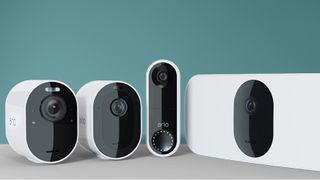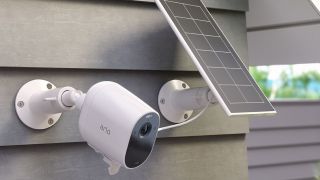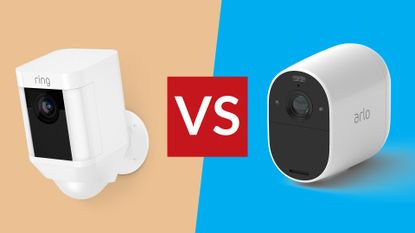The market for the best security cameras is very competitive right now, and two of the leading companies are Arlo and Ring. Ring was bought by Amazon in 2018, making it part of the world’s biggest retailer and leading provider of cloud storage and services (and a stablemate of another Amazon-owned security brand, Blink). Arlo may not have such a behemoth behind it, but in 2019 it was Europe’s leading home surveillance camera brand and America’s leading internet-connected camera brand.
Today in 2023, both companies offer a range of indoor and outdoor security cameras that work well with your digital home assistant and your smartphone, and while they’re not the only providers out there – check out our guide to the best cheap security cameras for more low-price options – their products are among the most compelling.
As we’ll discover, though, there are some important differences between the two firms’ products – not just in terms of their specifications or their price tags, but also in terms of what else they can connect to and where their footage might end up.
Arlo vs Ring: Pricing and range

As you’d expect from an Amazon company, Ring pricing is very aggressive. Ring’s cheapest video doorbell, the Video Doorbell Wired, is $59.99 / £49 / AU$119, and so is its cheapest wired security camera, the Ring Indoor WiFi Camera. A single outdoor wireless Spotlight Cam is $159.99 / £159 / AU$329.
Arlo’s range of cameras is very impressive, although the specific models available vary from country to country. In the US there are two indoor cameras, the Arlo Q and the Arlo Q Plus, and four indoor/outdoor cameras ranging from the entry level Arlo Essential to the Arlo Pro 4 and Arlo Ultra 2 with higher resolution video. There’s an LTE-connected mobile camera (the Arlo Go) and the incredibly cute Arlo Baby for keeping an eye on your little one. Arlo also offers two video doorbells and a very bright floodlight security camera.
Arlo’s products are generally more expensive. Its wired video doorbell is $129 / £109 / AU$199, and its cheapest security camera, the Arlo Essential is $129 / £109 / AU$199, while a single Arlo Ultra camera with base station costs $399 / £449 / AU$599. Again, there are options between these two.
Arlo vs Ring: Subscription costs

Smart cameras need a subscription to unlock useful features such as person detection.
To get the best from home security cameras you’ll need to subscribe to a storage plan, which also unlocks more advanced features such as people detection and package detection. Arlo's Premier Plan, the cheapest Arlo Smart option, is $2.99 / £2.49 / AU$4.49 a month for a single camera or $9.99 / £7.99 / AU$14.99 for up to 5 cameras. That gives you 30 days of cloud-based storage, plus the smart recognition features. CCTV-style continuous recording starts at $9.99 / £6.99 / AU$12.99 per month.
If you have lots of devices and cameras, Ring’s ongoing costs are lower. It offers two plans: Basic, which is $3 / £2.50 / AU$4 per month or $30 / £24.99 /AU$40 per year; and Plus, which is $10 / £8 / AU$15 per month or $100 / £80 / AU$150 per year. Basic is for one device and Plus is for all of your devices and includes 24/7 remote monitoring if you have a Ring Alarm. Storage here is for 60 days, not 30.
If smart doorbells are your thing, Ring has tons of them: the Ring site currently lists seven wired and wireless video doorbells. The rest of the camera range is simpler with wired, wireless and solar options: there’s the wired Indoor Cam, the wireless indoor/outdoor Stick Up Cam, and an outdoor Spotlight Cam and Floodlight Cam.
Amazon has also unveiled a flying Ring security drone, the Always Home Cam, which will be $250 and US-only, along with the Ring Car Alarm, Ring Car Cam and Ring Mailbox Sensor, although these products have not yet launched. Ring also has a selection of smart home alarm devices such as alarm panels and window sensors that integrate with the cameras.
Products from both ranges can be used without cloud storage. In Ring's case, this means you can only view footage live and not store it at all. That's also true of Arlo, with the exception that if you have an Arlo Smart Hub with USB storage connected, you can record footage to that.
Arlo vs Ring: Battery life

Arlo offers an optional solar charger while Ring offers solar versions of its outdoor cameras.
Arlo’s wireless outdoor security cameras are rated for six months between charges, and you can purchase an additional solar panel to keep them topped up and extend their life.
Ring promises six to twelve months on its totally wireless cameras between charges, depending on the number of activations. It too has solar versions for less frequent recharging.
Ring doorbells are more likely to last for a month or so, again depending on settings such as motion detection, and how often that triggers.
Arlo vs Ring: App

Both platforms have very slick mobile apps for iOS and Android that enable you to get a live view from your cameras and interact with visitors via two-way audio. Arlo’s iOS app also rich notifications with image previews and quick actions, an Apple Watch app and HomeKit integration.
Ring also enables you to get crime alerts from your neighbours, a feature that’s proved somewhat controversial in the US. The apps will notify you when motion is detected, whether that’s outside your house when you’re far from home or when baby moves while you’re on the sofa.
As you’d expect, Ring is very closely integrated with Amazon’s Alexa (including being able to ask to see video on your TV with an Amazon Fire TV Stick, or on an Amazon Echo Show device), but there's no integration with Apple HomeKit.
It’s worth mentioning here that Ring has attracted criticism in the US for its links with law enforcement: it has partnered with hundreds of police forces to give them potential access to camera footage in a kind of high-tech neighbourhood watch. As of January 2021 Amazon had partnered with over 2,000 US police forces and fire departments, sparking concerns about the creation surveillance network that will mean a lot of people are being watched by a system accessible by outsiders without knowing about it: according to the Electronic Frontier Foundation, “You may be consenting to be around a Ring’s camera and microphone, but your neighbours and nearby pedestrians may not.”
Ring's Control Center in its app gives you some control over this. You can opt out of any Video Requests to disable this sharing, and you can also see what other devices are connected to your system to ensure that you're not sharing your Ring cameras with any devices you don't want to share with. You can also specify which users should have access to which Ring devices.
Arlo vs Ring: Overall
Both companies offer products for complete home coverage from your front door to indoor and outdoor wireless cameras. Both offer person detection and audio, cloud storage and motion detection.
If you want to buy or begin to create a complete home security platform, Ring is the better option, because it stretches outside of just cameras. It's also cheaper to get into, meaning you get more devices for your initial investment.
But if it’s purely cameras you’re interested in, Arlo’s ones can deliver much better video quality with models capturing video at better-than-HD or even 4K with HDR.
The Ring range is more extensive than the Arlo one and is part of Amazon’s drive to be absolutely anywhere: its plans include Sidewalk, where neighbours’ devices would share connectivity to create a mesh network for everything from security devices and car alarms to lost-key tracking.



